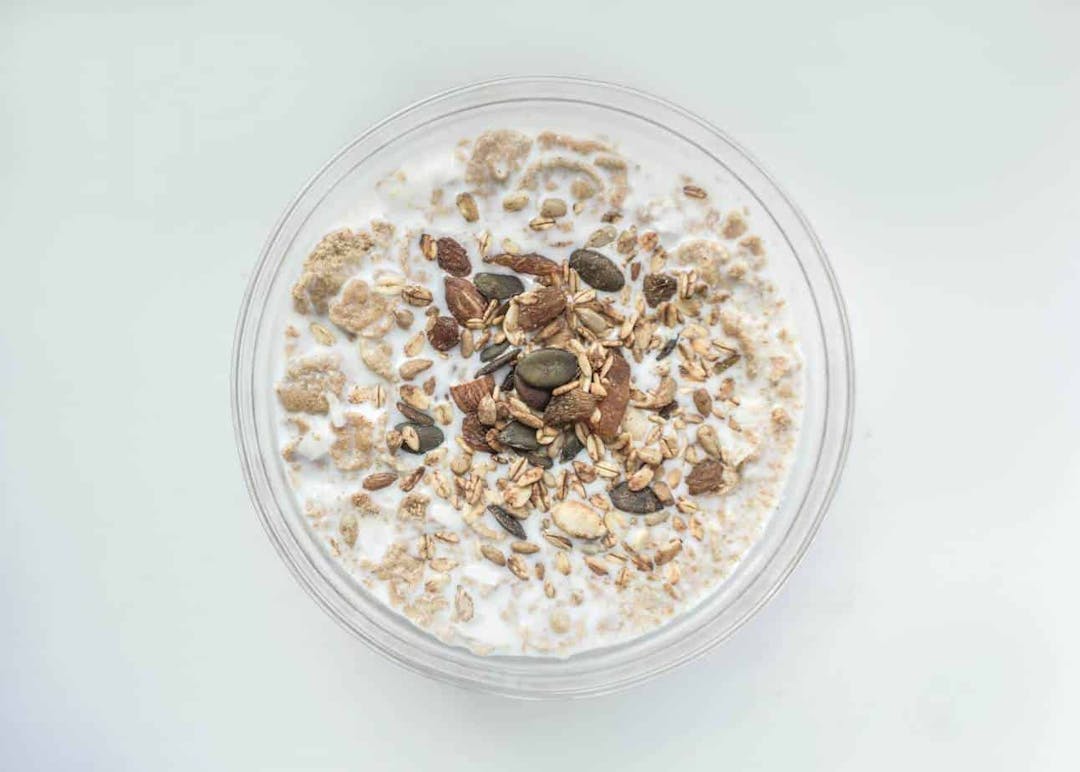


Find foods you can eat.
Q&A with Dietitian
Published on October 3, 2021We sat down for a Q&A with registered dietitian nutritionist, Rachel Dyckman, MS, RDN, CDN who used her clinical knowledge and experience as an IBD patient to answer a variety of questions submitted by FIG users!
Q: How did you become interested in nutrition?
A: My interest in nutrition stemmed from a young age, as I was diagnosed with ulcerative colitis (UC) when I was 8 years old. UC is an autoimmune disease that is a form of inflammatory bowel disease (IBD). UC can make eating particularly challenging during “flare ups,” or periods of active inflammation. When I was first diagnosed, I saw a dietitian who helped me navigate and understand how to use food as a tool to promote healing. I came to appreciate how food can have a significant impact on our health and disease activity. While diet is not the full picture and cannot necessarily cure UC alone, making dietary adjustments can greatly improve one’s quality of life and promote remission. As I got older and went on to major in environmental studies with a focus in food systems at Skidmore College, I learned how the way our food is produced not only impacts our environment, but also our health. I found myself gravitating more and more towards nutrition and decided to take a nutrition elective course. I liked it so much that I continued on to pursue my Master’s in Clinical Nutrition at NYU to help others improve their health and quality of life through food just as I had.
Q: What can a dietitian help with?
A: A dietitian can help someone manage a chronic illness, whether they are dealing with a gastrointestinal condition, cardiovascular disease, diabetes, kidney disease, and much more. Dietitians can also help educate individuals on general nutrition principles improve their overall health. We work with people to understand their nutrition needs and any challenges that they may be facing so that we can provide specific advice, meal suggestions, food preparation ideas, and more, all individualized to the person’s specific needs.
Q: What do you specialize in?
A: I help people with all aspects of nutrition but I have particular expertise in weight management, cardiovascular health, blood sugar management, and gastrointestinal conditions including IBD, gastroesophageal reflux, food intolerances, and more.
Q: How can you ensure you’re getting all of the nutrients you need in your diet?
A: The easiest way to ensure that you are meeting your nutritional needs is to eat the widest variety of foods that you can, incorporating foods from all food groups. Aim to include non-starchy vegetables, a protein source, a healthy fat, and a carbohydrate source at most meals. It is also important to focus on consuming mostly whole, minimally processed foods, as these foods tend to have the highest nutrient density. Getting routine bloodwork done is a good idea if there is a specific nutrient that is a concern for you. For example, if historically your iron stores have been low, it is helpful to have them checked periodically so that you can either increase certain foods in your diet to correct the deficiency or take a supplement if needed and as directed by your doctor or dietitian.
Q: What has helped you the most with your UC?
A: I don’t strictly follow one particular diet, but I do incorporate many aspects of the IBD AID (IBD Anti-Inflammatory Diet). The IBD AID was developed by UMass Medical School Center for Applied Nutrition and is intended to help manage flares and promote remission in those with IBD by improving the gut microbiome. The diet is broken down into phases based on an individual’s level of disease activity. I try to incorporate many prebiotic fiber sources into my diet, meaning foods that selectively feed good gut microbes. I also try to incorporate food sources of probiotics into my diet daily, such as yogurt, sauerkraut, kimchi, and miso.
I do my best to avoid dietary emulsifiers such as carrageenan, maltodextrin, polysorbate-80, and carboxymethyl cellulose, as these additives have been linked to intestinal inflammation. During flares, I utilize texture modification techniques such as blending fruits and vegetables into smoothies and soups, pureeing vegetables, and using soft-cooking methods such as steaming. This helps to make prebiotic fiber-rich foods easier to digest so that I can tolerate them and still encourage the growth of beneficial gut microbes.
Q: How do you shop and make food for yourself?
A: I try to have a few recipes in mind that I will make each week. I plan ahead by creating a grocery list over the weekend with the ingredients that I need. I also incorporate as many seasonal, locally grown foods as possible. One of my favorite things to do is visit my local farmer’s market to see what’s in season. I get inspiration from farmer’s markets, as they often have unique varieties of fruits and vegetables that I normally would not try. I find it helpful to stock my freezer with certain items for convenience. I always have frozen bags of vegetables on hand to throw into whatever I’m cooking (they’re frozen at peak ripeness and just as nutritious as fresh!), frozen berries to add to smoothies, and frozen proteins that I can easily defrost and cook like fish, chicken, and turkey. Lastly, I try to take one step towards meal prep each weekend to make life easier, for example, roasting a batch of vegetables to add to lunches and dinners during the week.
Q: I think I may benefit from the IBD-AID diet. What should my next steps be?
A: First, if you are experiencing GI symptoms but have not yet received a diagnosis or found an explanation for your symptoms, it is best to see a gastroenterologist to be evaluated, as many conditions like IBD generally require medical intervention. If you are interested in adopting the IBD AID, you can visit the UMass Center for Applied Nutrition website. There, you will find many helpful resources including overall guidelines for the diet with a checklist of foods to incorporate each day, foods that are avoided on the IBD AID, recipes, and information on each phase of the diet. Working with a dietitian who specializes in IBD can also help to guide you and ensure that you are meeting your nutrition needs.
Q: How does one start a plant-based diet?
A: Start by focusing on eating mostly whole, plant-based foods rather than simply replacing animal products with heavily processed alternatives. Think about where your carbohydrates, protein, and fat are coming from at each meal to ensure that you are getting the nutrition you need. Make sure your protein intake is adequate by incorporating plant-based protein sources like beans, legumes, tofu, tempeh, quinoa, nuts, seeds, and nut and seed butters into your diet. If you are fully vegan, consider taking a vitamin b12 supplement and possibly a vegan omega-3 supplement, as these nutrients can be difficult to obtain through a plant-based diet. Focusing on eating a wide array of different plants will help to ensure that you are getting the nutrients you need. The Fig aisle and ingredient scanner can help you identify foods that are plant-based!
Q: How significant is BPA on the effect of gut problems?
A: BPA is a chemical compound used to line cans. Studies suggest that BPA may promote changes in the gut microbiome that are not favorable and promote intestinal inflammation. Unfortunately, many cans that are BPA free may contain BPS to replace it, and according to preliminary research it appears that BPS may have similar effects on the gut microbiome. That said, these studies have been conducted on mice, so it’s hard to say for sure and to determine the dose at which BPA or BPS causes these changes in humans. Occasionally eating canned foods is likely not a problem, but if you consume canned foods very frequently, I would consider opting for versions in glass jars or Tetra Paks instead.
Q: I’m currently in a sweet spot with a modified low FODMAP diet for IBS-D but have not had success with any of the alliums. Should I try reintroducing them?
A: Alliums are a very common IBS trigger, as they contain fructans, a type of FODMAP. It is very possible for one’s tolerance to a particular FODMAP to change over time since the gut microbiome is constantly evolving. It is actually recommended that once symptoms are under control in the “maintenance” phase of the low FODMAP diet, FODMAPs that were not tolerated previously are periodically retested. This way, you will be able to see if you can reintroduce those foods again. I would recommend keeping portions very small at first and testing these foods on days when you don’t have much going on (little stress, you are eating most meals at home, you slept well the night before, etc.). If you don’t experience symptoms, you can gradually increase portion sizes and see how you feel.
Q: I’m having flare ups with IBS even though I’m eating low FODMAP foods. The flare ups have occurred after eating ground turkey, spinach, turkey bone broth.
A: First, I would be sure that the bone broth does not contain garlic, onion, or any other high FODMAP ingredients. Aside from FODMAPs, there are other potential symptom triggers such as stress, poor sleep quality, eating large portions of fat within one sitting, spicy foods, and caffeine. It’s also a good idea to spread your food intake out evenly throughout the day so that you don’t feel overly hungry by dinner time and eat a larger amount in one sitting which may cause symptoms. If you are still experiencing symptoms, working with a dietitian who specializes in IBS can be helpful to pinpoint your specific triggers.
Q: If you have food intolerances or allergies that extremely affect your day to day food intake, how can you combat the discouragement that results from that?
A: You are certainly not alone — so many people struggle with this. It can help to find foods within your dietary restrictions that you truly enjoy and are excited about eating. Keep these foods on hand and also look for recipes on food blogs that are geared towards dietary restrictions. Trying a new recipe each week will add variety to your meal rotation. You can even use a regular recipe but experiment with making substitutions to suit your needs. When eating out at restaurants, plan ahead by looking up the menu beforehand to find suitable options for you. You can even call the restaurant before you go to see if substitutions can be made. There are also many support groups online and through social media dedicated to specific dietary restrictions that can be helpful.
Q: What are some common nutrition issues that you have come across?
A: Food allergies and autoimmune diseases have becoming increasingly prevalent. One theory behind these phenomena is the “hygiene hypothesis.” The idea is that as a society, we are overly sterile and don’t expose our immune systems to enough microorganisms, particularly in childhood. As a result, our immune system overreacts to things it shouldn’t such as foods we eat or our own bodies in the case of autoimmune diseases. The gut microbiome also likely plays a role. Studies show that those with a more diverse and robust gut microbiome have fewer incidences of food allergies and autoimmune diseases.
Q: Should I cut out gluten and dairy for IBD?
A: There currently is not sufficient evidence to support eliminating gluten and dairy entirely for IBD. In fact, certain gluten and dairy-containing foods appear to be beneficial for gut health. For example, barley contains gluten but is also a great source of prebiotic fiber. Plain Greek yogurt is dairy but also contains probiotics. Anecdotally, some find that eliminating gluten and dairy helps with IBD symptom management but this may be the result of the individual eating fewer processed foods or foods high in saturated fat when they eliminate gluten and dairy. In IBD patients with overlapping IBS, symptom improvement may be related to FODMAPs rather than gluten and dairy themselves. Gluten-containing foods tend to be high in fructans and many dairy foods contain lactose, both of which are types of FODMAPs that may trigger functional GI symptoms in those with IBS.
Q: What is the process for working with a dietitian?
A: To find a dietitian, you can visit Eat Right and type in your zip code. Many dietitians offer telehealth which is just as effective as in-person sessions. We generally start by taking a detailed health history, asking about your usual dietary intake, and finding out about your lifestyle and food preferences. Based on this information, we provide dietary recommendations that are specific to you and your needs.
Q. Are dietitians covered by insurance?
A. Some dietitians take insurance, especially if they are affiliated with a hospital network, but many in private practice do not. If they do not, they usually can offer a superbill which can then be submitted to your insurance company for potential partial or full reimbursement depending on your plan and the reason for your visit.
Q: What is one overarching piece of nutrition advice that you would give people?
A: One great general piece of nutrition advice that is applicable to most people is Michael Pollan’s famous quote, “eat [real] food, not too much, mostly plants.” I will add that it’s also important to be an educated consumer with regard to what you’re eating. Look at food labels, learn where your food comes from, and of course use apps like FIG to help you make food choices that are suitable for you and your specific needs!
Q: How can people get in touch with you?
A: You can email me at rachel@racheldyckmannutrition.com, visit my Instagram page @racheldyckmannutrition, or visit my website, racheldyckmannutrition.com. I look forward to connecting!
 The Impact of Dietary Emulsifiers on Gut Health
The Impact of Dietary Emulsifiers on Gut Health A Dietitian’s Guide to Alternative Milks
A Dietitian’s Guide to Alternative Milks